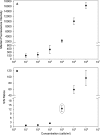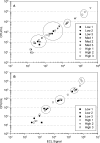Same-day detection of Escherichia coli O157:H7 from spinach by using electrochemiluminescent and cytometric bead array biosensors
- PMID: 21037307
- PMCID: PMC3008225
- DOI: 10.1128/AEM.01990-10
Same-day detection of Escherichia coli O157:H7 from spinach by using electrochemiluminescent and cytometric bead array biosensors
Abstract
Contamination of fresh produce with Escherichia coli O157:H7 and other pathogens commonly causes food-borne illness and disease outbreaks. Thus, screening for pathogens is warranted, but improved testing procedures are needed to allow reproducible same-day detection of low initial contamination levels on perishable foods, and methods for detecting numerous pathogens in a single test are desired. Experimental procedures were developed to enable rapid screening of spinach for E. coli O157:H7 by using multiplex-capable immunological assays that are analyzed using biosensors. Detection was achieved using an automated electrochemiluminescent (ECL) assay system and a fluorescence-based cytometric bead array. Using the ECL system, less than 0.1 CFU of E. coli O157:H7 per gram of spinach was detected after 5 h of enrichment, corresponding to 6.5 h of total assay time. Using the cytometric bead array, less than 0.1 CFU/g was detected after 7 h of enrichment, with a total time to detection of less than 10 h. These results illustrate that both biosensor assays are useful for rapid detection of E. coli O157:H7 on produce in time frames that are comparable to or better than those of other testing formats. Both methods may be useful for multiplexed pathogen detection in the food industry and other testing situations.
Figures





Similar articles
-
Automated immunomagnetic separation for the detection of Escherichia coli O157:H7 from spinach.Int J Food Microbiol. 2014 Jun 2;179:33-7. doi: 10.1016/j.ijfoodmicro.2014.03.022. Epub 2014 Mar 28. Int J Food Microbiol. 2014. PMID: 24718031
-
Multiplex real-time PCR assay for detection of Escherichia coli O157:H7 and screening for non-O157 Shiga toxin-producing E. coli.BMC Microbiol. 2017 Nov 9;17(1):215. doi: 10.1186/s12866-017-1123-2. BMC Microbiol. 2017. PMID: 29121863 Free PMC article.
-
Photobleaching with phloxine B sensitizer to reduce food matrix interference for detection of Escherichia coli serotype O157:H7 in fresh spinach by flow cytometry.Food Microbiol. 2013 Dec;36(2):416-25. doi: 10.1016/j.fm.2013.07.007. Epub 2013 Jul 31. Food Microbiol. 2013. PMID: 24010624
-
Electrochemical biosensors for rapid detection of Escherichia coli O157:H7.Talanta. 2017 Jan 1;162:511-522. doi: 10.1016/j.talanta.2016.10.050. Epub 2016 Oct 12. Talanta. 2017. PMID: 27837864 Review.
-
Methods for the detection and isolation of Shiga toxin-producing Escherichia coli.Symp Ser Soc Appl Microbiol. 2000;(29):133S-143S. doi: 10.1111/j.1365-2672.2000.tb05341.x. Symp Ser Soc Appl Microbiol. 2000. PMID: 10880188 Review.
Cited by
-
Modernization of Control of Pathogenic Micro-Organisms in the Food-Chain Requires a Durable Role for Immunoaffinity-Based Detection Methodology-A Review.Foods. 2021 Apr 11;10(4):832. doi: 10.3390/foods10040832. Foods. 2021. PMID: 33920486 Free PMC article. Review.
-
Recent Advances in Electrochemiluminescence Sensors for Pathogenic Bacteria Detection.Micromachines (Basel). 2019 Aug 13;10(8):532. doi: 10.3390/mi10080532. Micromachines (Basel). 2019. PMID: 31412540 Free PMC article. Review.
-
In Silico and Electrochemical Studies for a ZnO-CuO-Based Immunosensor for Sensitive and Selective Detection of E. coli.ACS Omega. 2021 Jun 11;6(24):16076-16085. doi: 10.1021/acsomega.1c01959. eCollection 2021 Jun 22. ACS Omega. 2021. PMID: 34179653 Free PMC article.
-
Biosensors for the Detection of Food Pathogens.Foods. 2014 Sep 2;3(3):511-526. doi: 10.3390/foods3030511. Foods. 2014. PMID: 28234334 Free PMC article. Review.
-
A sandwich-type bacteriophage-based amperometric biosensor for the detection of Shiga toxin-producing Escherichia coli serogroups in complex matrices.RSC Adv. 2020 Sep 30;10(59):35765-35775. doi: 10.1039/d0ra06223e. eCollection 2020 Sep 28. RSC Adv. 2020. PMID: 35517084 Free PMC article.
References
-
- AOAC International. April 2010, posting date. Performance tested meth- ods. AOAC International, Gaithersburg, MD. http://www.aoac.org/testkits/testedmethods.html.
-
- Bird, C. B., R. J. Hoerner, and L. Restaino. 2001. Reveal 8-hour test system for detection of Escherichia coli O157:H7 in raw ground beef, raw beef cubes, and iceberg lettuce rinse: collaborative study. J. AOAC Int. 84:719-736. - PubMed
-
- Brehm-Stecher, B., C. Young, L. A. Jaykus, and M. L. Tortorello. 2009. Sample preparation: the forgotten beginning. J. Food Prot. 72:1774-1789. - PubMed
-
- Caprioli, A., S. Morabito, H. Brugère, and E. Oswald. 2005. Enterohaemorrhagic Escherichia coli: emerging issues on virulence and modes of transmission. Vet. Res. 36:289-311. - PubMed
-
- Centers for Disease Control and Prevention. 30 June 2009, posting date. June 30 update on multistate outbreak of E. coli O157:H7 linked to eating raw, refrigerated prepackaged cookie dough. Centers for Disease Control and Prevention, Atlanta, GA. http://www.cdc.gov/ecoli/2009/0630.html.
Publication types
MeSH terms
LinkOut - more resources
Full Text Sources
Other Literature Sources
Molecular Biology Databases

